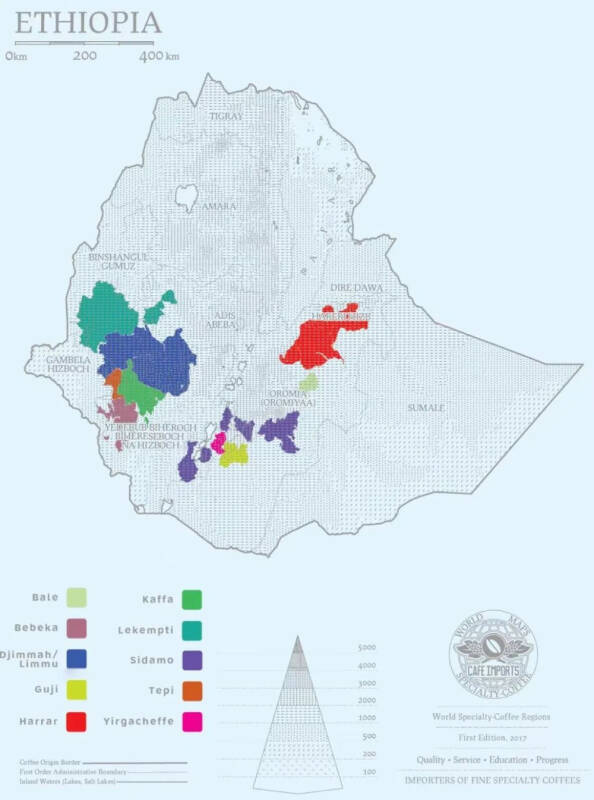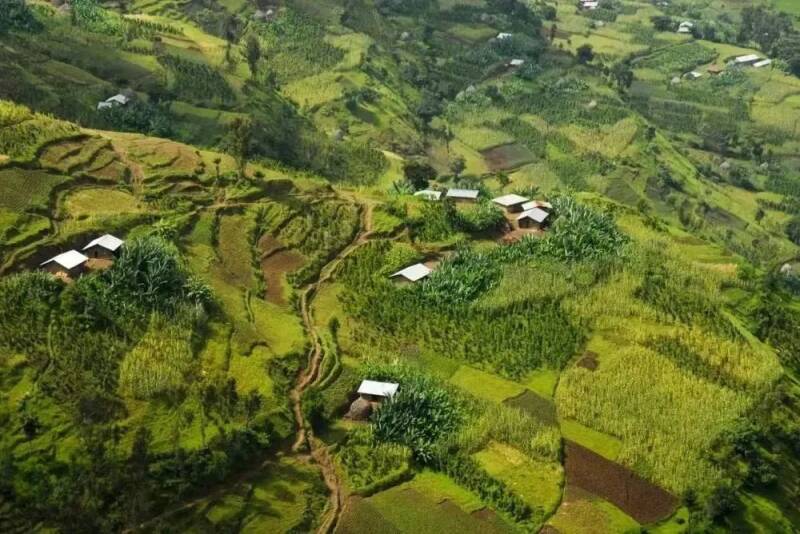Introduction of Coffee beans from Sidamo, Ethiopia, 74158 and Santa Vini
Ethiopia is the largest Arabica producer in Africa, has a long history of coffee, and Ethiopia is recognized as the birthplace of coffee. There is a wide variety of coffee, and it is estimated that there are now 10000 to 15000 coffee varieties in Ethiopia, most of which have not yet been formally identified. In Ethiopia, there are many well-known coffee producing areas, such as Sidamo Sidamo, Guji Guji, Yegashifi Yirgacheffe, Jinma Jima, Haller Harrar and so on.

Sidamo producing area
The Sidamo producing area is located in the south of Ethiopia, bordering Kenya. After 1995 Ethiopia adopted a federal system and the local government replanned according to the major ethnic settlements and languages out of respect for the culture of all ethnic groups in the country. In this way, Sidama was placed under the jurisdiction of the new Southern National language Autonomous Prefecture, which was renamed as the original historical name: Sidama. But at that time, in order to strengthen the promotion of the uniqueness of coffee in the country, the Ethiopian government applied for a patent for the names of three producing areas in 2004, choosing the old name Sidamo ®as the registration of Cedama Coffee. Until now, domestic consumers have always been used to calling the coffee here "Sidamo".

There are many different soils and microclimates in the Sidamo producing area, which make the coffee produced in this producing area have obvious characteristics and quality. In the producing area, there are mountains, plateaus, valleys and plains and other diverse topography. And the geology of the area is rich in nutrients and has a well-drained volcanic soil, which can provide an ideal growing environment for coffee. And there are many well-known processing plants in the Sidamo production area, such as the Santa Veni treatment plant, the Gauss treatment plant and so on.
Santa Vini treatment Plant and treatment method
The Santa Vini Shantawene processing plant is about 40 minutes from the small town of Santa Veni, and DWD has 17 processing plants in the Sidamo area, one of which is at high altitude. Compared with Cognate DWD's Gauss processing plant, Santa Vini's climate is drier and the average temperature is lower, and even with the same treatment, the details are not the same. For example, the same fermentation treatment takes longer in Santa Vini.
At present, the Santa Vini coffee beans bought in front of the street are exposed to the anaerobic sun for 96 hours. The coffee berries will be sorted and selected after harvest, and the selected coffee berries will be put into a fermentation bucket and injected with carbon dioxide for 96 hours of anaerobic fermentation. After the fermentation is completed, take it out, put it on the viaduct for drying, and turn it over regularly for about 20-24 days, and the moisture content can be reduced to 12%.
Digital coffee varieties
At present, Ethiopian coffee varieties are divided into two types: JARC varieties and regional varieties. Regional varieties refer to the wild-growing varieties of Ethiopian forest coffee planted in the region. Because there are too many kinds of coffee beans in Ethiopia and it is difficult to distinguish them, they are generally referred to as "Heirloom". Heirloom is translated into native species or family heirloom in Chinese.
The JARC variety was developed by the Jimma Agricultural Research Center (JARC), one of the Ethiopian Agricultural Federal Research Centers. From 1973 to 1975, the research center identified and planted 639 different coffee varieties through the collection of coffee beans from 15 regions. Among these samples, a total of 13 beans performed well, with the characteristics of disease resistance, high yield, drought tolerance and good flavor. Therefore, JARC classifies these beans as "1974/1975CBD-Rexistent Selections". That is, the numbering series, and the common ones are 74110 and 74158. The first two digits, 74x75, refer to the year in which they were found, while the number after 74ap75 is the variety number. The Santa Vini coffee beans from the front street are the digital variety 74158.
Front Street Coffee Ethiopian Santavini Coffee beans
Production area: Sidamo manor / treatment plant: Santa Veni treatment plant altitude: 2050 meters varieties: 74158 treatment method: 96 hours anaerobic treatment flavor: fermented wine fragrant pineapple citrus tropical fruit red wine
Qianjie Coffee bought this Santavini coffee bean from Sidamo, Ethiopia, which is treated with 96 hours of anaerobic sun treatment. The front street is boiled with V60rade 1 / 15 ratio, there will be a slight aroma of fermented wine, the entrance will have soft citrus acid, pineapple and other tropical fruit flavor, mellow, full-bodied, red wine finish.
Important Notice :
前街咖啡 FrontStreet Coffee has moved to new addredd:
FrontStreet Coffee Address: 315,Donghua East Road,GuangZhou
Tel:020 38364473
- Prev

Recipe to match yourself! Lucky worker: I'm crazy busy!
▲ Click to follow| Daily Coffee Culture Magazine Coffee Workshop With the increasing demand for daily coffee among working people, the demand for novelty is also increasing. In order to meet the personalized needs of consumers, some coffee chain brands and private shops began to offer customized taste options.
- Next

NKG, the world's largest coffee and raw bean trading company, announces the closure of its business in Kenya
Recently, according to local reports in Kenya, Neumann Kaffee Gruppe, the world's largest trader of raw coffee beans, referred to as NKG, announced the closure of its factory in Kenya, mainly due to failure to obtain a government license. It is understood that Neumann Kaffee Grup
Related
- What effect does Italian American coffee with filter paper have? Will coffee taste better if it is put on filter paper at the bottom of the powder bowl?
- What is the color difference in coffee beans? What are the characteristics of honey processed coffee beans? Why are the anaerobically treated coffee beans uneven in color?
- How does novice Xiaobai quickly get started and make coffee? Newbies learn to make coffee by hand and share the specific steps and process process!
- Costa tea has a shelf life of 100 years?! Expert: Unable to verify
- It's a huge uproar! American milk addition was rejected by Manner employees?!
- Mocha pot coffee bean recommendations| How fine and how much powder should be used for grinding? What parameter ratios do I need to use to make milk with Mocha pot coffee?
- What are the characteristics of the world's top ten coffee beans treated with Costa Rica honey? How to make black honey kadura from Tarazhu Pilon Processing Plant taste good?
- How to make deep-roasted coffee? What grinding water temperature does authentic Jamaica Blue Mountain No. 1 coffee use to brew it well?
- Selected high-grade rose summer coffee flavor tasting guide Why Panama rose summer has the aroma of flowers and fruits
- What equipment does a novice Xiaobai need to buy to learn to make coffee? Filter cup electronic scale bean grinder manual flushing pot purchase guide

